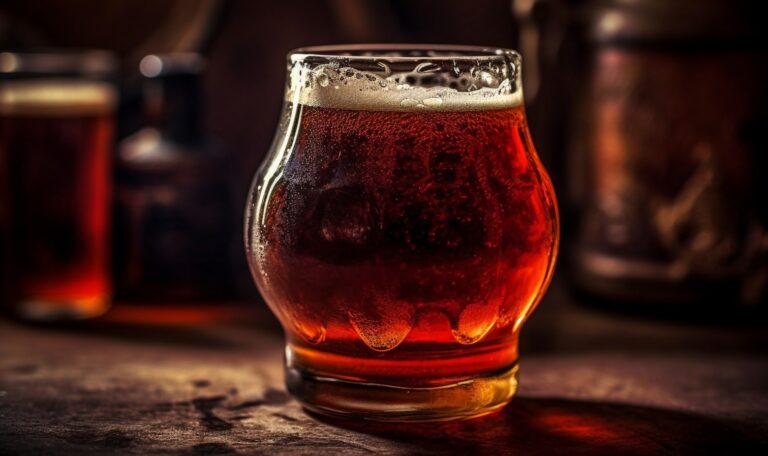Is Beer Heavier Than Water?
The weight of beer is determined by its density, which is influenced by factors such as its ingredients, sugar content, and alcohol concentration. Beer is often referred to as “heavy water” colloquially, highlighting its denser nature than pure water due to dissolved sugars and other compounds.
This increased density is measured using specific gravity, a metric that quantifies the ratio of the density of a substance to the density of water. The specific gravity of beer gives insight into its overall composition and contributes to its unique taste, texture, and mouthfeel.

So Is Beer Heavier Than Water?
YES, beer is heavier than water, with very few exceptions. The Final Gravity of beer measures the beer’s weight when the fermentation is completed. While Original Gravity is measured before fermentation, Final Gravity is measured when the brewing process is completed. Most beers have a Final Gravity of 1.000 to 1.030:
- Light American lagers – 0.998 to 1.008 (some American lagers can be lighter than water)
- Irish stouts – 1.007 to 1.011
- American IPAs – 1.010 to 1.018
- American Barleywine – 1.016 to 1.030
(this means that the average Irish stout is 1.007 to 1.011 times heavier than water)
Weight Of Water
Water is of the fundamental components crucial for life on Earth. Encompassing over 70% of our planet’s surface, it plays an indispensable role in the survival of all living organisms. Yet, have you ever pondered the weight of water? The weight of water is a product of its mass, which signifies the quantity of matter encompassed within.
Typically measured in kilograms (kg) or grams (g), its everyday estimation often employs liters (L) or milliliters (mL) as a metric of volume. The computation of water’s weight involves the multiplication of its volume by its density. The density of water stands at approximately 1 gram per cubic centimeter (g/cm³) or 1 kilogram per liter (kg/L). Consequently, 1 liter of water equates to 1 kilogram or 1000 grams in weight.
The Density Of Water
Similarly, 1 milliliter of water carries a weight of 1 gram. Therefore, envision a vessel brimming with 5 liters of water – its weight would register at 5 kilograms or 5000 grams. Likewise, a smaller receptacle accommodating 250 milliliters of water would denote a weight of 250 grams.
It’s worth emphasizing that the weight of water is subject to alterations contingent upon temperature and pressure fluctuations. The thermal expansion upon heating and contraction upon cooling lead to changes in water’s density. At the temperature of 4°C, where water is at its densest, 1 liter of water registers a weight of 1 kilogram.
However, the water’s weight becomes variable as the temperature veers away from this point. For instance, at 20°C, 1 liter of water exhibits an approximate weight of 0.998 kg; at 100°C, it demonstrates around 0.958 kg. This underscores that water’s weight diminishes as temperature escalates due to its expansion.
When it comes to pressure, water’s weight can differ depending on its depth. The weight augments with depth due to the pressure exerted by the water above. With every 10 meters of descent, the pressure elevates by 1 atmosphere, tantamount to 1 kg/cm². In summation, the weight of water draws from its mass, calculated by the multiplication of its volume by its density.

Weight of Beer
Beer predominantly consists of water, and when served at the cooler temperatures commonly enjoyed (6–9°C), water’s density closely approximates 1 g/ml. Ethanol contributes 4–6% to the composition of a typical beer, and being less dense than water, one might anticipate beer to be slightly less dense as well. However, residual sugars in beer tend to counterbalance this effect, often resulting in a final specific gravity (post-fermentation) of approximately 1.010. In simpler terms, beer ends up about 1% heavier than water. Beers with higher alcohol content usually retain more residual sugars, making them denser. The density of beer varies depending on the specific type, but around 1.01 kg per liter is a fairly typical measurement.
The variation in weight hinges on the specific beer type. The characteristic you’re considering is referred to as the Final Gravity, usually hovering around 1008 kg/m³. However, exceptionally robust beers can reach up to roughly 1015 kg/m³. Consequently, 1 liter of beer can weigh anywhere from 1.008 to 1.015 kg. An intriguing observation lies in its weight surpassing water’s; an alcohol-water mixture would be lighter (under 1 kg).
The weight of the beer can vary based on its specific gravity, which is influenced by factors like ingredients, sugars, and alcohol content. Generally, heavier beers have a higher specific gravity, indicating greater density due to more dissolved solids.
Therefore, high-alcohol or malt-rich beers like stouts, porters, and IPAs tend to be heavier compared to lighter styles like lagers or pilsners. Keep in mind that while these beers are denser than water, the differences in weight are typically not substantial and are usually measured in grams or kilograms per liter.
Quick fact: A liter and a kilogram are distinct measurements. The liter quantifies the volume of either a container or a substance. Specifically, a liter corresponds to the volume encompassed by a cube, with each side measuring 10 cm (equivalent to 10 cm³). On the other hand, the Kilogram pertains to measuring mass, signifying the quantity of substance within an object. It serves as a unit of mass measurement.
Wrapping It Up
In conclusion, the weight of beer is a nuanced characteristic influenced by various factors, primarily its specific gravity. While beer is often playfully referred to as “heavy water,” its weight can fluctuate based on the content of ingredients such as sugars and alcohol. Generally, beers with higher specific gravity, like malt-rich or high-alcohol styles, tend to be denser and thus heavier than water.
However, the differences in weight are usually modest and measured in grams or kilograms per liter. The interplay between ingredients, brewing methods, and the resulting density shapes the weight of beer, contributing to the diverse range of flavors and textures enthusiasts enjoy.

I am a young architect with a passion that goes beyond blueprints… it’s beer! undertherosebrewing.com is more than just a blog, it’s a manifestation of my lifelong dream to explore, read, and learn everything about beer. Join the blog on this unfiltered and genuine adventure into the heart of beer culture. Cheers!






